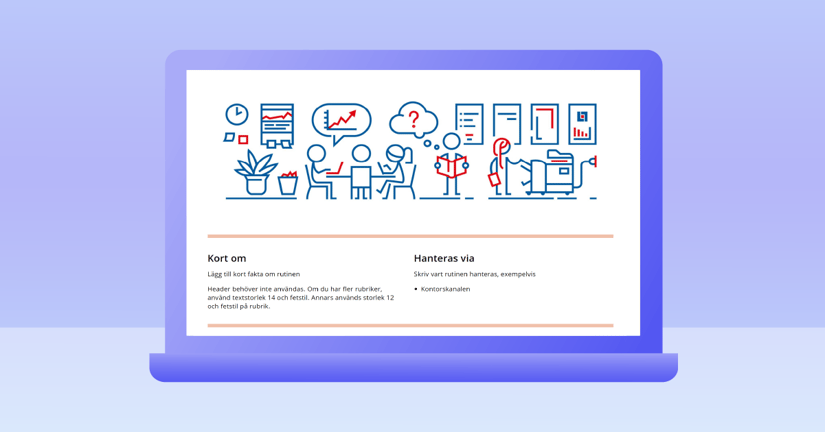In most businesses, there are a variety of routines with the aim of ensuring quality and giving employees support during their working day. However, routines are often lacking in how to create and share these routines efficiently and with a good user experience. By spending time creating conditions and guidelines for creating routines, the business has a lot to gain.
A journey towards standardization and single point of truth
Often when it comes to routines, they are continuously created at different times, by different people, and for different purposes. If there are no guidelines on how these should be formed and shared, it is also natural that there is a lack of uniformity in handling, which leads to a certain uncertainty for the person who is to create and read the routine. If routines are to be created that will be widely shared in the business, we therefore usually recommend that, at least on some level, the layout of the routine be adjusted. It will streamline the creation process and make it easier for the employee to find the information, as it is presented in the same way regardless of subject and author. If you also add a graphic layer with recurring colors and shapes, it contributes to recognition and security in the material that the end user is looking for.
If an important part is to find the routine, then, of course, another important part is to find the routine. In this context, we usually raise the concept of Single point of truth - which, in short, means that there must be a place where you know you can find the "truth," i.e., the most relevant and most recently updated routines. If there is no clear Single point of truth, it will mean that unnecessary time is spent looking for the right routines and that employees lean towards outdated routines and thus lose quality in the execution.
Following routines can have different importance, but if you work in banking, it's not something you joke about. Because many tasks are complex, and you have legal requirements to handle and follow routines correctly. Due to this, Länsförsäkringar has taken a serious approach to how they can effectively create and share routines within the business. Below we can read more about Länsförsäkringar's journey toward a more efficient creation process.
Länsförsäkringar's journey
This is what Cassandra Isgren, Business Developer at Länsförsäkringar Bank, says about their work:
"The background to the work to create a portal and template for our routines is based on the fact that we previously used an overview (manual) which was difficult to keep track of given that we had more than 200 routines. Employees pulled together to create new routines because it was difficult to understand the structure we set up with the overview and categorization that did not come naturally. In the work, we had two goals: we needed to make it easier to create routines for us who work in the tool, but also to make it more user-friendly for those who will absorb the information. Hence, the work landed in a portal where we built a widget for each unit within the Bank. Subsequently, sub-portals were created for each unit, where we have now collected routines, manuals, and information aimed at the specific unit. This has created a better user experience for our users because we refreshed with images, easier ways to search for the material but mainly the ability to see the most viewed guides and their favorites directly in the portal. A big plus for our users is that they can now easily see when a routine is updated via a widget. We have also built a communication tool into our sub-portals, which is much appreciated. When we make major changes to the routines/manuals (guides), we post news that informs the user about the update and what's updated with an invitation to read the routines. In this way, we believe that we will generate more value for our users and make them aware of when they need to update themselves on a routine basis.
As for us who work with the tool, we also needed to create something that supports our work. The result was that we produced an example template with clear instructions for which headings, images, and fonts should be used. This facilitates our work and makes it easy and also fun to create a new routine because you have the support you need. We have also produced a routine description for internal work where the various sections used in the routine are explained and what functionality they fulfill for the end users.
In summary, we needed to create a simpler everyday life where our work in Infocaption became easier for us as users of the platform but also create a fresher end product for the end users, which we think we have succeeded in, and the end users seem to agree with us as the feedback has been very nice with cheers and encouraging words both linked to the portal and the routines."
 Click here to see the template that Länsförsäkringar reuses for its routines (in Swedish)
Click here to see the template that Länsförsäkringar reuses for its routines (in Swedish)
Länsförsäkringar receives the Guide of the Month award
Every month we at InfoCaption appoint the Guide of the Month - a guide that we want to highlight a little extra because of the value it creates in the organization. As a thank you to the person(s) who created the Guide of the Month, we donate SEK 1,000 monthly to Hand in Hand Sweden, which fights poverty by creating more jobs in vulnerable countries. Hand in Hand works with the "help to self-help" model, which is in line with InfoCaption's own mission "to make it easier for employees to help each other."
We in the InfoCaption team think that Länsförsäkringar's work in creating conditions for simplicity with the help of reusable templates and searchable portals is completely in line with our mission. We believe that is worth celebrating.

